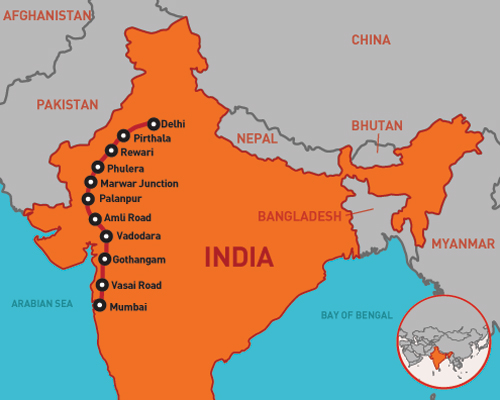
Project: Delhi-Mumbai Industrial Corridor
Cost: $90 Billion
The Indian Cabinet last month approved the restructuring and financing for the future $90-billion Delhi-Mumbai Industrial Corridor, opening the way for forward for the ambitious megaproject planned along a future 1,483-kilometer high-speed-rail freight corridor. India’s rail ministry expects to invite bids this year for $2.2 billion worth of civil engineering contracts for the rail corridor’s first phase. The first seven cities of the 24-city industrial corridor are set for completion in 2018.
The purpose of the equity restructuring, under which 51% of the combined shares of two infrastructure and financing companies will be transferred to government-owned financial firms, is to maintain transparency and avoid conflicts of interest between project participants at a later stage, say sources. As a result of the Sept. 16 government action, the Delhi-Mumbai Industrial Corridor Development Corp. (DMICDC), with a 49% share in the industrial corridor project, will become a government company open to government audits.
Plans call for a 1,483-kilometer-long industrial corridor that will run through seven states. In total, there would be nine industrial megazones, each 200-250 sq km, and 24 new cities. Each zone would be located along the future 1,500-km high-speed freight line that will connect landlocked Delhi—in the north-central section of the subcontinent—southwest to Mumbai on the Arabian Sea. The government has not released any time frame for completion of the overall development.
“The basic objective of the [industrial corridor] is to drive manufacturing. Only then can India hope to keep growing at 9% to 10%, year-on-year,” says Amitabh Kant, CEO and managing director of DMICDC.
Land acquisition will be one of many challenges, say sources. Connecting highways, railways and ports to the new cities will be another, says Kant.
The Challenge of Financing
However, the main challenge will be financing. Unlike China, India will look at public-private partnerships, with part of the funding coming from the private sector. “In this, the government has a major role [because] these new cities [will] cost money,” he says. “The first seven cities that we plan to develop will cost between $8 billion to $15 billion, which is what Dholera, the largest development plan, is likely to cost,” says Kant.

Post a comment to this article
Report Abusive Comment